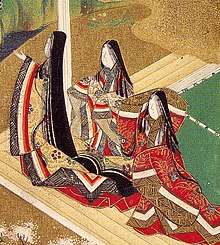Furisode
A furisode (振袖, "swinging sleeves") is a style of kimono distinguishable by its long sleeves, which range in length from 85 centimeters for a kofurisode (小振袖, lit., "short swinging sleeve") to 114 centimeters for an ōfurisode (大振袖, lit., "large furisode"). Furisode are the most formal style of kimono worn by young women in Japan.[1]
The sleeves, like all women's kimono, are attached to the body of the kimono only at the shoulder, with the inner edge left open past the shoulder. This both allows the underkimono (juban) to show when worn, and also allows the obi to be tied around the body above the hips. Furisode, like other formal kimono, are mostly made from silk, and are decorated in bright colours to reflect the wearer's youth. Furisode are often either rented or bought by parents for their daughters to wear on Coming of Age Day in the year they turn 20.
In previous decades, only young unmarried women wore furisode, as marriage signified the end to a woman's single youth and the beginning of her transition into married life; higher rates of marriage at a younger age left few women unmarried past their mid-twenties, meaning that furisode were never seen on older unmarried women. In the present day, the unwritten rules of kimono formality have relaxed over time, meaning that both married and unmarried young women have the choice to wear other types of formal kimono to events that require formal dress. The furisode is generally worn for formal social functions such as tea ceremonies and weddings.[2]
History

The furisode originated in the mid-1500s as middle- and upper-class children's clothing, worn by both boys and girls; it was not worn by adults.[3] Initially, the furisode had relatively short sleeves, and was used as everyday wear by those who could afford it. Over time, as the sleeves lengthened and became more exaggerated, the furisode became a style of kimono worn mostly to special occasions. According to one 17th-century text, boys could wear furisode until their 18th year, or until they went through their coming-of-age ceremony, which usually occurred in late adolescence. Girls were supposed to cease wearing the furisode upon marriage, or upon reaching their 20th year.[4]
Initially, furisode did not differ noticeably between the sexes, but fabric designs started to become more gendered in the 19th century.[5] In the 20th century furisode became restricted to women and girls only, as part of the increasing gender-specificity of children's clothing that developed in the wake of Western influence.[6] As the furisode became increasingly associated with young adult women, the term was removed from the shorter-sleeved children's garment, which acquired the more generic term "wakiake" (open-sided).[7]
Gallery
.jpg) Furisode with Paulownia Tree and Phoenixes, Late 18th-early 19th century, Los Angeles County Museum of Art
Furisode with Paulownia Tree and Phoenixes, Late 18th-early 19th century, Los Angeles County Museum of Art 19th century furisode, Indianapolis Museum of Art
19th century furisode, Indianapolis Museum of Art Furisode, Japan, 1920-1940, The Khalili Collection of Kimono
Furisode, Japan, 1920-1940, The Khalili Collection of Kimono- Furisode, 1930s, Textile Museum (George Washington University)
 Kimono with birds in flight, 1942, Metropolitan Museum of Art
Kimono with birds in flight, 1942, Metropolitan Museum of Art
References
- "Furisode Kimono - Kimonogeisha.com". Kimonogeisha. Retrieved 2018-05-18.
- "What's a Furisode? All About Japan". All About Japan. Retrieved 2018-05-18.
- "Bimonthly Magazine "REKIHAKU" No.137 A Witness to History|Back Number|Bimonthly Magazine "REKIHAKU"|Publication|Outline|National Museum of Japanese History". www.rekihaku.ac.jp. Retrieved 2018-05-18.
- Nagasaki, Iwao (1994). Furisode. Kyoto: Fujioka Mamoru. p. 93.
- Sawada, Kazuto. "Furisode and teenage boys". Bimonthly Magazine "REKIHAKU". National Museum of Japanese History. Archived from the original on 22 May 2013. Retrieved 9 May 2014.
- "Furisode Kimono Guide". Japan Talk. Retrieved 2018-05-18.
- "Furisode The Kyoto Project". thekyotoproject.org. Retrieved 2018-05-18.
External links

